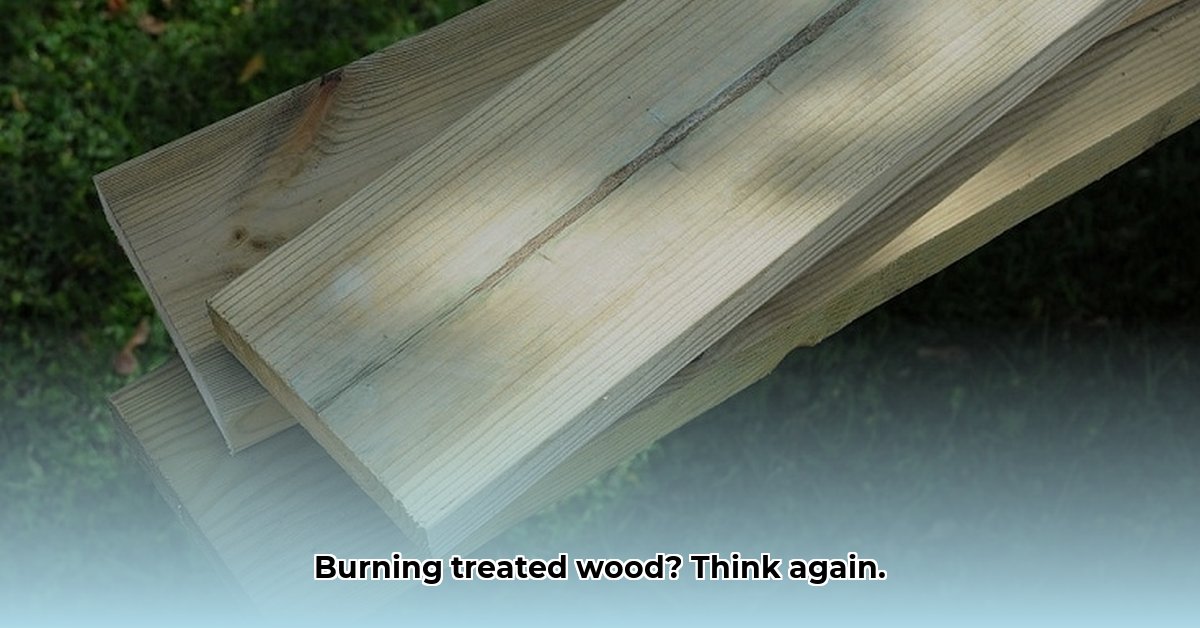No, burning pressure-treated wood is dangerous and should be avoided. This wood contains chemical preservatives that, when burned, release harmful toxins into the air, posing risks to your health and the environment.
Why Burning Pressure-Treated Wood is Dangerous
Pressure-treated wood’s durability comes from preservatives like arsenic, chromium, and copper compounds. While effective against rot and insects, these chemicals become hazardous when burned, releasing toxic fumes and contaminating the resulting ash.
Health Risks
Inhaling these fumes can lead to various respiratory issues, from mild irritation to more severe problems. Some studies even suggest a potential link between exposure to these chemicals and an increased risk of certain cancers.
Environmental Hazards
Contaminated ash can pollute soil and water sources, potentially harming plants, animals, and entering the food chain. This contamination can have long-term consequences for the local ecosystem.
Safe Disposal of Pressure-Treated Wood
Disposing of pressure-treated wood requires caution and responsible action. Here are some safe alternatives to burning:
1. Recycling
Some facilities specialize in recycling treated lumber, recovering valuable materials and minimizing environmental impact. Check with your local recycling center for availability.
2. Designated Landfills
Many landfills have specific areas for pressure-treated wood to ensure proper handling and prevent chemical leaching. Contact your local waste management authority for locations and procedures.
3. Professional Disposal Services
For large quantities, consider hiring a professional disposal service trained in handling hazardous materials for safe and compliant disposal.
4. Repurposing (Non-Burning)
Explore repurposing possibilities that don’t involve burning, such as creating raised garden beds (with barriers to prevent direct soil contact), retaining walls, or outdoor furniture. Exercise caution and research potential risks before repurposing.
Identifying Pressure-Treated Lumber
Correctly identifying pressure-treated wood is crucial for safe handling. Here’s how:
1. Visual Inspection
Look for a greenish or grayish tinge (though this can fade), small holes or incisions from the treatment process, and stamps or tags indicating “treated” or “PT.”
2. Water Test
Sprinkle water on the wood. If it beads up or takes longer to absorb compared to untreated wood, it likely suggests treatment.
3. Chemical Test
For definitive confirmation, use a chemical test kit specifically designed to detect preservatives in pressure-treated wood, available at hardware stores or online.
Handling Pressure-Treated Wood Safely
Even when not burning, handle treated wood with care:
- Wear gloves, safety glasses, and a dust mask to minimize chemical and dust exposure.
- Wash your hands thoroughly after handling.
- Consult local regulations for specific handling and disposal guidelines.
Legal Implications and Accidental Burning
Burning pressure-treated wood is illegal in many areas due to environmental and health risks. Check with your local authorities to avoid potential fines. If you accidentally burn some, ensure proper ventilation, extinguish the fire completely, and seek medical advice if necessary.
Alternatives to Pressure-Treated Lumber
Consider using naturally rot-resistant woods like cedar or redwood for future projects, offering environmental benefits and simplified disposal. While potentially more expensive initially, the long-term advantages may outweigh the initial cost.
Ongoing Research and Future Considerations
Research continues to explore long-term exposure effects to chemicals in treated wood. Scientists are also developing more environmentally friendly preservatives and methods for detoxifying contaminated soil. Staying informed about these developments is crucial for making responsible decisions.
By understanding the risks, following safe disposal methods, and exploring alternatives, you can protect yourself, your community, and the environment while enjoying the benefits of wood in your projects.
- Adult Bento Box Lunch Ideas For Quick Healthy Portable Options - December 25, 2025
- Adult Bento Meal Ideas for Delicious, Easy, and Healthy Lunches - December 24, 2025
- Adult Bento Box Ideas for Delicious and Easy Lunches - December 23, 2025










